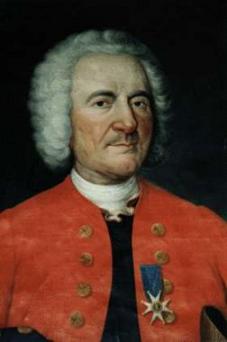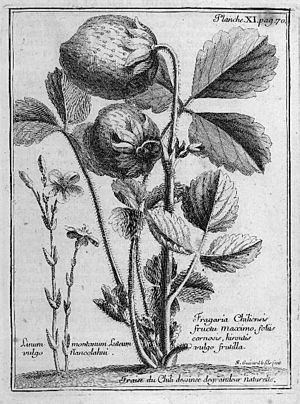Amédée-François Frézier facts for kids
Amédée-François Frézier (born in 1682 – died October 26, 1773) was a French engineer, mathematician, spy, and explorer. He is most famous for bringing five special strawberry plants from South America to Europe. These plants were a new type of strawberry, called the beach strawberry, which changed how strawberries were grown around the world!
Contents
Frézier's Family Story
Did you know Frézier's last name, "Frézier," comes from the French word for "strawberry," which is fraise? It's true! A long time ago, a man named Julius de Berry was given a special award by a king in 916. Why? Because he gave the king some delicious ripe strawberries at just the right time!
Because of this, the family (whose name later became "Frazer") was given a special symbol for their family crest: three strawberries!
Later, some members of the Frazer family moved to Scotland. They helped the Scottish king fight against invaders. The king rewarded them with land and kept the strawberry symbol on their family crest.
Around 1500, a man named Édouard Frazer returned to France. His family eventually settled in a place called Savoy.
Young Amédée: A Love for Science
Amédée-François Frézier was born in Chambéry, France, in 1682. His father, Pierre-Louis Frézier, was a well-known lawyer and professor. He wanted Amédée to become a lawyer too.
But Amédée had other plans! He was much more interested in science. So, he went to Paris to study science and religion. He even wrote a paper about how to navigate ships and understand stars.
After his science studies, Frézier traveled to Italy. There, he learned about art and buildings. These skills later helped him when he studied forts and defense structures. Around 1700, he returned to France and joined the army.
The Book of Fireworks
Even though he was in the army, Frézier had time for his hobbies. He wrote a book called Treatise on Fireworks in 1706. This book wasn't about military explosives. Instead, it was all about fireworks for fun shows and celebrations!
Frézier's book explained how to make beautiful, decorative fireworks. It became a very popular guide for people who made fireworks.
Because of this amazing book, Frézier was moved to the military intelligence team. He became a military engineer in a town called Saint-Malo.
Adventures in South America
Frézier's bosses were very impressed with his skills. They chose him for a very important mission: to study the defense forts in Chile and Peru, in South America.
In 1712, Frézier, who was a lieutenant-colonel, set sail for South America. His secret mission was to map the coastlines and important ports. He also needed to check the strength of the Spanish forts.
He sailed on a ship called the St. Joseph for about five months. He went around the famous Cape Horn and arrived in Concepción, Chile, in June 1712.
Frézier pretended to be a trader or a ship captain. This allowed him to visit the forts as if he were just a tourist. He made friends with the Spanish governors. While there, he secretly drew maps of the ports. These maps showed the best ways to attack, where weapons were kept, and escape routes.
He also gathered information about the Spanish government, the lives of the local people, and the gold and silver mines. He even reported on the plants and animals he saw. And that's where the strawberry story comes in!
Frézier noticed a special type of strawberry. He wrote: "They grow whole fields of a type of strawberry different from ours. Its fruit are usually as large as a whole walnut, and sometimes as a small egg. They are of a whitish-red color and a little less delicate to the taste than our woodland strawberries." He brought five of these amazing beach strawberry plants back to Europe!
A Voyage to the South-Sea
All the information Frézier collected was very valuable. His travel stories and maps were published in a book in Paris in 1716. It was called Relation du voyage de la mer du Sud.
This book was so popular that it was quickly translated into other languages. An English version, A Voyage to the South-Sea, came out in 1717. It was a huge success!
Frézier also wrote other works, including a letter about the history of earthquakes in Lima.
Awards and More Travels
Frézier left South America in 1714 and arrived back in France in August. He was allowed to show his maps to King Louis XIV, who was very impressed. The King gave Frézier a reward of 1,000 gold coins!
In 1719, Frézier went back to the "New World." He was sent to Hispaniola (now Haiti and the Dominican Republic) for two years. His job was to make the island's defenses stronger. He made a map of the island and a plan of Santo Domingo City.
He got sick with malaria there, but finally returned to Europe in 1728. When he came back, he received a special award called the cross of St. Louis. In 1752, he became a member of the French Academy of Sciences, a group of very smart people.
Work in Europe
Back in Europe, Frézier continued his engineering work. He built many defense structures in places like Philippsburg and Landau.
He also wrote an important book about how to cut stones and wood for buildings. It was called The theory and practice of cutting stones and wood for the construction of vaults. This book became a standard guide for architects and builders. It explained how to use geometry to build complex shapes like arches and domes.
In 1739, he became the Director of Fortifications for all of Brittany, a region in France.
Frézier retired in 1764, but he never stopped learning. He was interested in many things, like how to remove salt from water, building design, and how to navigate ships. It is said he read for at least six hours every day, especially books about travel and history.
He passed away in Brest, France.
See also
- Jean-Charles Perrinet d'Orval
Gallery























